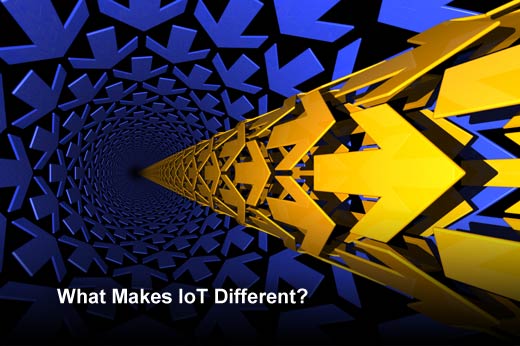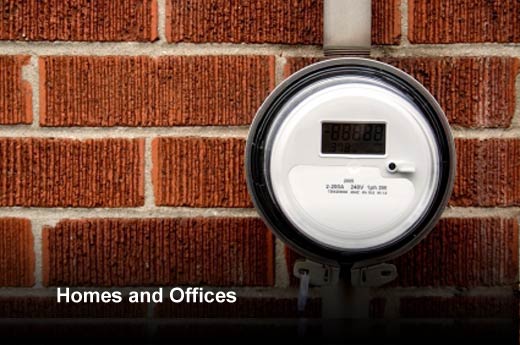The Internet of Things (IoT) is not just the connected refrigerator. It’s thousands of medical devices in hospitals, smart utility meters, GPS-based location systems, fitness trackers, toll readers, motion detector security cameras, smoke detectors, and last but not least, embedded systems. Each of these IoT end nodes requires connectivity, processing and storage, some local and some in the cloud. This means scalability and application elasticity to adapt to dynamic requirements and ever-changing workloads.
To support and accommodate all the devices, sensors and other network-connected gadgets that will eventually become part of the IoT, network designs will need to adapt and become more application centric, according to KEMP Technologies. From health care to automotive and manufacturing to consumer electronics, the Internet of Things is a quantum revolution in how we think about application data activity. Is your network ready for the application onslaught that’s coming?

Preparing for the IoT
Click through for more on developing an application-centric network that’s capable of supporting the ever-growing IoT, as identified by KEMP Technologies.

Get Ready
The IoT is all the rage. It’s the buzzword de jour. Whether it’s lauded in the popular press, technology journals or industry conference keynotes, it’s hard to escape the moniker and very easy to dismiss the IoT as hype about smart refrigerators that remind you when to buy more milk. But, it’s more than that, way more.
Gartner predicts that the IoT will bring a total economic value-add of $1.9 trillion by 2020, and the number of connected devices will reach 26 billion, while information managed by enterprises will grow by 14x.

What Makes IoT Different?
The IoT extends the end node far beyond the human-centric world to encompass specialized devices with and without human-accessible interfaces. As IoT grows, the need for real-time scalability to handle dynamic traffic bursts also increases. There may be the need to handle very low-bandwidth small data streams – such as a sensor identifier and a status bit on a door sensor, or large high-bandwidth streams – like HD video from a security camera. There is almost always the need for encryption, as well.
The scope of IoT is huge. In some cases, the end node may be a low-powered embedded microcontroller with sensors, hard wired to an industry network, running 24/7.

Hospitals
Hospitals utilize several smart devices, both standalone and those wired to nurses’ station monitors. Soon these will be interconnected through a highly available and secure network with service-based applications that can track patient conditions by correlating all data – not just nurses’ readings – allowing better monitoring, data logging and Big Data analytics. Staff will be able to focus on delivering the best care based on deterministic information.
An IoT connected network helped St. Luke’s Medical Center reduce patient-bed turnaround by 51 minutes.

Homes and Offices
Utility meters send complex data packets to service providers where centralized systems provide real-time monitoring to proactively detect and remediate problems, such as blackouts, water leaks and circuit overloads. Data is analyzed to improve efficiency by determining needs, spotting trends, and predicting demands.
By virtue of its smart IoT fixtures, the city of Oslo reduced energy costs by 62 percent.

Factories and Warehouses
The flow of materials must be monitored and optimized for efficiency. Location sensors are embedded in components moving through assembly lines and inventory systems. The locations of forklifts, pallets and workers are tracked as well, while centralized software directs and redirects the activity in real time to effectively respond to customer requests.
By implementing predictive maintenance along with quality control IoT, BMW reduced auto-warranty costs by 5 percent and reduced the scrap rate of defective vehicles by 80 percent.

Wearables
From heartbeat-sensing fitness bands to step-counting smartphone apps, wearables are the public face of IoT. A portable device is connected to a service that aggregates data and, increasingly, shares it across social media, with a doctor or even a gym. The cloud-based services also push back analytics, motivational graphics and music, as well as location-based maps.

Challenges
An IoT application may have hundreds, thousands, or even millions of participating devices. Sometimes the number of connections and the amount of data will be consistent and predictable, but not always. Here are a few of the more pressing challenges to providing backend connectivity and customer satisfaction in IoT applications:
Handling Huge Amounts of Traffic Including Bursts
Imagine a motion detector video camera that maintains a minimal connection to a cloud-based application server, perhaps a periodic “heartbeat” packet that provides operational status. When the motion detector is tripped, the camera suddenly kicks into gear and transmits streams of HD video to be stored and analyzed. Or, imagine the burst of data coming from, say, runners wearing fitness bands at a sporting event like the New York City Marathon.
IoT systems designers should plan to manage any quantity of data in unpredictable bursts without dropping packets, overloading the network or overwhelming servers – all while accommodating the BI analytics software required to make sense of the data, often in real time.

Challenges
Maintaining Fast Response Time and Quality of Service
Consumers and employees expect fast response time to their mobile apps, as do embedded industrial applications. A warehouse application that directs workers to pick up and deliver materials is a failure if it freezes or is slow to process location-awareness packets. The server infrastructure and network design of an IoT application needs to be focused on both maintaining fast response time and ensuring robust quality of service (QoS), especially in real-time, location-aware applications.

Challenges
Security, Privacy and Regulatory Compliance
Applications store current and historical data about an individual’s health, location and finances, as well as trade secrets, such as the location and quantity of inventory, business orders and more. Data must be secured against theft and tampering. This can be challenging when data is transmitted across the Internet or even secured private networks and VPN tunnels. Government regulations such as HIPAA or restrictions on transporting data across international borders may also apply. Key IoT security tasks will be to ensure that proper application-level protections, such as DDoS-attack mitigation, reach out to end points and incorporate measures confirming the identity of entities requesting access to data, including multi-factor authentication.

Modern Load Balancing
The Evolution of the Modern Load Balancer
Modern load balancers (ADCs) focused on application delivery are more sophisticated and operate from Layer 4 to the Application Layer 7, making them more in tune with application server software, how the client responses should be handled, and the specific services being requested by IoT end nodes.
ADCs provide packet encryption/decryption, reducing server workload and making it possible to apply advanced policies and processing on secured traffic streams while maintaining end-to-end security.
Global server load balancing (GSLB) allows the intelligent distribution of end-node traffic across private and public clouds based on proximity, performance, or manually-defined business rules, for optimal data handling and communication.
To facilitate the dynamic cloud infrastructure, modern ADCs have also been adapted to integrate into virtual environments.
With simple configuration and portability, virtual ADCs meld seamlessly into private clouds with hypervisor, so administrators can launch applications quickly. Since these are application focused, IoT users are assured that instances are supported and functioning as they should, not just in the context of being in VM, but for the application they are serving.

Modern Load Balancing
NFV (Network Functions Virtualization)
NFV decouples basic network functions, including firewalling, network address translation (NAT), load balancing and security filtering from running in hardware and application specific integrated circuits (ASICs) to run in software, making it easy to increase scalability and boost performance, as administrators or automation software can quickly and easily allocate new resources.
Since IoT encompasses devices that could be anywhere, connected via any network, the ability to replace costly hardware in fixed locations with software provides optimum flexibility. NFV services can be configured on the fly, so management software can dynamically improve the user experience and meet QoS requirements.
NFV service chaining refers to all of the virtual physical devices and software-based services required to connect all parts of an application, from the router to load balancer to multiple application servers, database servers, Web servers and other NFV services, like WAF (Web application firewall).
There may be many IoT devices scattered across data centers and cloud providers. Provisioning and monitoring the service chain is costly and time-consuming, especially with proprietary networking hardware, a variety of operating systems, and a mix of vendor-specific management tools. Service chaining is more easily enabled with NFV because virtualized network functions can be provisioned and re-provisioned entirely through software, to support the workload or customer requirements. These technologies – advanced load balancers or ADCs, NFV and service chaining – are well suited for the ever growing Internet of Things economy.




















